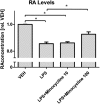Anti-inflammatory effects of minocycline are mediated by retinoid signaling
- PMID: 30241502
- PMCID: PMC6151010
- DOI: 10.1186/s12868-018-0460-x
Anti-inflammatory effects of minocycline are mediated by retinoid signaling
Abstract
Background: Minocycline is a lipophilic tetracycline of increasing appeal in neuroscience as it inhibits microglial activation, a mechanism involved in numerous neuropsychiatric disorders. Own data point towards retinoid-mediated effects of minocycline in murine brain and skin, and towards a vicious cycle of neuroinflammation which is driven by microglial activation-induced breakdown of local retinoids such as retinoic acid (RA). We therefore sought to study minocycline's anti-inflammatory effects on human microglial-like monocyte-derived cells in the context of retinoid signaling.
Results: As hypothesized, minocycline exposure resulted in a substantial increase of RA levels in the human monocytic cell line THP-1. While pro-inflammatory stimulation with lipopolysaccharides resulted in increased tryptophane-degrading indoleamine-2,3-dioxygenase IDO-expression and TNF-α levels in primary human monocyte-derived microglial-like cells, this effect was attenuated by minocycline only in the presence of retinoids. The anti-inflammatory effects of minocycline on TNF-α expression were completely abolished by a pharmacological blockage of retinoic acid receptors (RARs) using BMS-493 and unaffected by selectively blocking retinoid-X-receptors using UVI-3003.
Conclusions: Our data indicate for the first time a RA-dependent, anti-inflammatory effect for minocycline in human microglial-like cells via inhibition of local RA turnover. The RA-dependent mode of action for minocycline appears to be predominantly mediated through RAR-signaling.
Keywords: Cytokines; Microglia; Minocycline; Neuroinflammation; Retinoic acid.
Figures





Similar articles
-
Retinoic acid receptor agonist Am80 inhibits CXCL2 production from microglial BV-2 cells via attenuation of NF-κB signaling.Int Immunopharmacol. 2016 Sep;38:367-76. doi: 10.1016/j.intimp.2016.06.025. Epub 2016 Jun 25. Int Immunopharmacol. 2016. PMID: 27351827
-
Inhibition of retinoic acid catabolism by minocycline: evidence for a novel mode of action?Exp Dermatol. 2015 Jun;24(6):473-6. doi: 10.1111/exd.12692. Epub 2015 Apr 16. Exp Dermatol. 2015. PMID: 25810318
-
Inhibition of brain retinoic acid catabolism: a mechanism for minocycline's pleiotropic actions?World J Biol Psychiatry. 2016 Dec;17(8):634-640. doi: 10.3109/15622975.2015.1036116. Epub 2015 Jun 5. World J Biol Psychiatry. 2016. PMID: 26047390
-
Minocycline and cytoprotection: shedding new light on a shadowy controversy.Curr Drug Deliv. 2007 Jul;4(3):225-31. doi: 10.2174/156720107781023938. Curr Drug Deliv. 2007. PMID: 17627496 Review.
-
Profile of minocycline and its potential in the treatment of schizophrenia.Neuropsychiatr Dis Treat. 2014 Jun 17;10:1103-11. doi: 10.2147/NDT.S64236. eCollection 2014. Neuropsychiatr Dis Treat. 2014. PMID: 24971013 Free PMC article. Review.
Cited by
-
Clozapine modulates retinoid homeostasis in human brain and normalizes serum retinoic acid deficit in patients with schizophrenia.Mol Psychiatry. 2021 Sep;26(9):5417-5428. doi: 10.1038/s41380-020-0791-8. Epub 2020 Jun 2. Mol Psychiatry. 2021. PMID: 32488128 Free PMC article.
-
Inflammation-Induced Tryptophan Breakdown is Related With Anemia, Fatigue, and Depression in Cancer.Front Immunol. 2020 Feb 21;11:249. doi: 10.3389/fimmu.2020.00249. eCollection 2020. Front Immunol. 2020. PMID: 32153576 Free PMC article. Review.
-
Neuroinflammatory Loop in Schizophrenia, Is There a Relationship with Symptoms or Cognition Decline?Int J Mol Sci. 2025 Jan 1;26(1):310. doi: 10.3390/ijms26010310. Int J Mol Sci. 2025. PMID: 39796167 Free PMC article. Review.
-
Autism spectrum disorder and a possible role of anti-inflammatory treatments: experience in the pediatric allergy/immunology clinic.Front Psychiatry. 2024 Jun 24;15:1333717. doi: 10.3389/fpsyt.2024.1333717. eCollection 2024. Front Psychiatry. 2024. PMID: 38979496 Free PMC article. Review.
-
Retinoid homeostasis in major depressive disorder.Transl Psychiatry. 2023 Feb 23;13(1):67. doi: 10.1038/s41398-023-02362-0. Transl Psychiatry. 2023. PMID: 36813763 Free PMC article.
References
-
- Levkovitz Y, Fenchel D, Kaplan Z, Zohar J, Cohen H. Early post-stressor intervention with minocycline, a second-generation tetracycline, attenuates post-traumatic stress response in an animal model of PTSD. Eur Neuropsychopharmacol. 2015;25:124–132. doi: 10.1016/j.euroneuro.2014.11.012. - DOI - PubMed
-
- Yang Y, Salayandia VM, Thompson JF, Yang LY, Estrada EY, Yang Y. Attenuation of acute stroke injury in rat brain by minocycline promotes blood-brain barrier remodeling and alternative microglia/macrophage activation during recovery. J Neuroinflammation. 2015;12:26. doi: 10.1186/s12974-015-0245-4. - DOI - PMC - PubMed
-
- Seki Y, Kato TA, Monji A, Mizoguchi Y, Horikawa H, Sato-Kasai M, Yoshiga D, Kanba S. Pretreatment of aripiprazole and minocycline, but not haloperidol, suppresses oligodendrocyte damage from interferon-gamma-stimulated microglia in co-culture model. Schizophr Res. 2013;151:20–28. doi: 10.1016/j.schres.2013.09.011. - DOI - PubMed
Publication types
MeSH terms
Substances
LinkOut - more resources
Full Text Sources
Other Literature Sources
Research Materials

